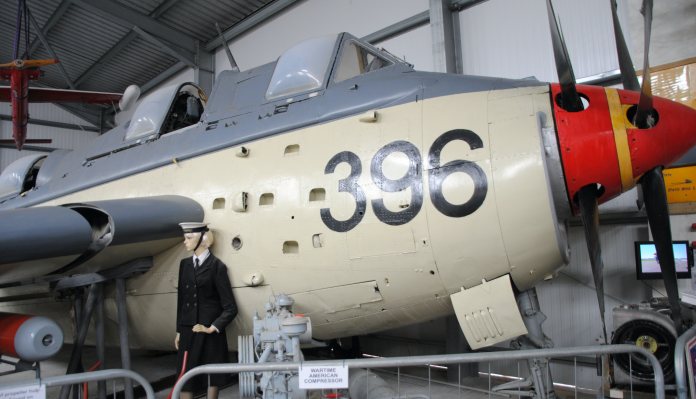The Cornwall at War Museum
-
0
 Comments
Comments
- Last updated: 07/12/2023

The county of Cornwall has a long and rich military heritage that stretches back across the centuries and continues to this day. Projecting out into the North Atlantic and with a coastline extending partially along the western end of the English Channel, Cornwall has been used for naval bases and airfields from where aircraft and ships patrolled in the defence of Britain.
During WWII, a number of airfields were constructed to increase the strength of existing defensive measures, including RAF Davidstow, which was operational between 1942 and 1945. Some 17 different squadrons, flying aircraft such as Beaufighters, Liberators, Supermarine Walrus, and Wellington bombers, flew missions at various times as part of Coastal Command. The operational roles included anti-submarine and Air Sea Rescue to save aircrews who had ‘ditched’ in the sea. After the war, Davidstow Airfield was closed in 1945 and put to civilian use for a range of purposes, which included motor racing for a time.
Today, the airfield is the home of the Davidstow Airfield and Cornwall at War Museum, which is accessed from the A395 road leading from Launceston and just before the junction with the A39 leading to Camelford. Better known simply as the Cornwall at War Museum, the site, which opened in June 2007, utilises many of the original buildings and hangars. Here, exhibitions of items are displayed, covering both world wars and the period known as the Cold War.
The museum is owned and operated by Steve Perry and his wife, Sheila, who between them have acquired some 95% of the artefacts displayed, with the remainder being donated, for which they are grateful. In the early days, most of the exhibition was confined to what had once been the officers’ mess but has now expanded across the site to encompass the original Stanton air raid shelter and blast trenches, which can be entered. Steve explained how important it is to “own the land on which you stand”, meaning he is free from outside interference.
On arriving at the site, drivers are directed through the entrance gate to park inside the perimeter, from where visitors make their way to the ticket office. Here they receive an information sheet to guide them around the site to make sure they see everything. It has a nice, friendly, relaxed air about it, and visitors can wander around at their own pace, taking time to read the captions, study the exhibits, and take photographs. This is a personal collection and Steve and Sheila have every right to be proud of what they have achieved. Comments posted on the Trip Adviser website reflect this hard work, with some 1,300 positive reviews, each one of which is a recommendation in itself.
This is a museum which is growing all the time, with a new hangar being opened in 2016 to accommodate more items in the collection. Some exhibits have a subtle, tongue-in-cheek, humorous connotation within the display, but never so much as to detract from the factual history being conveyed.
This is a site which has something for all members of a family group, with a display of animals used in the war, which younger visitors will enjoy, through to the Home Front, which older visitors will be able to relate to. In-between age groups will find this a fascinating mixture of items, some of which might be familiar, but many more that will be new. All interest groups are also covered, from uniforms to weapons, which will please collectors, vehicles to technology, such as the RAF St Mawgan & Joint Maritime Facility display in one of the buildings, and anti-aircraft missiles.
Both world wars are featured in separate displays, with different aspects of WWII being covered as individual subjects, such as Operation Chastise, and the 1943 Dam Buster raid, complete with a realistic figure representing Guy Gibson’s dog. For those with an interest in making military models, there is a fine display showing aircraft and other subjects, which might provide inspiration for dioramas and even naval subjects.
It is the hardware which makes up the bulk of the collection, however, with artillery, machine guns, and vehicles. For example, the hanger contains a range of post-war vehicles, including an example of a Humber ‘Pig’ armoured personnel carrier along with Land Rovers, a Scammell Explorer recovery vehicle, and other items which National Servicemen will recognise.
Moving outside, visitors can enter the different air raid shelters and take in the larger exhibits, such as a narrow-gauge Motorail railway engine and a rare example of a Pickett-Hamilton Fort as used to protect airfields during the war. Special guided tours around the airfield, travelling on the minibus nicknamed ‘Marlene’, can be booked as an extra, to visit outlying parts of the airfield to see the size of the site from its wartime days.
When coming to a site as interesting as this, it is difficult to suggest how long a visit will last. With so many subjects covered, satisfaction is guaranteed and unexpected surprises keep visitors engaged. In effect, time spent on site at this absorbing museum depends on a person’s interest. The military service of the Martyn family, for example, extending over both world wars is worth tracking down. There is certainly plenty to choose from in the range of exhibitions, including musical instruments of regimental bands, through to personal artefacts in the form of photographs.
It is laid out to allow access for wheelchair users and dogs are welcome, which makes a nice change. There is a shop on site and a selection of second-hand military books is available in a couple of the display areas. Full details of opening times, along with booking for an airfield tour around the site, can be found at www.cornwallatwarmuseum.co.uk
